实验1 类与对象最终版
// 标准库string, vector, array基础用法
#include <iostream>
#include <string>
#include <vector>
#include <array>
// 函数模板
// 对满足特定条件的序列类型T对象,使用范围for输出
template<typename T>
void output1(const T &obj) {
for (auto i : obj)
std::cout << i << ", ";
std::cout << "\b\b \n";
}
// 函数模板
// 对满足特定条件的序列类型T对象,使用迭代器输出
template<typename T>
void output2(const T &obj) {
for (auto p = obj.begin(); p != obj.end(); ++p)
std::cout << *p << ", ";
std::cout << "\b\b \n";
}
// array模板类基础用法
void test_array() {
using namespace std;
array<int, 5> x1; // 创建一个array对象,包含5个int元素,未初始化
cout << "x1.size() = " << x1.size() << endl; // 输出元素个数
x1.fill(42); // 把x1的所有元素都用42填充
x1.at(0) = 999; // 把下标为0的元素值修改为999
x1[4] = -999; // 把下表为4的元素值修改为-999
cout << "x1: ";
output1(x1); // 调用模板函数output1输出x1
cout << "x1: ";
output2(x1); // 调用模板函数output1输出x1
array<int, 5> x2{x1};
cout << boolalpha << (x1 == x2) << endl;
x2.fill(22);
cout << "x2: ";
output1(x2);
swap(x1, x2); // 交换array对象x1, x2
cout << "x1: ";
output1(x1);
cout << "x2: ";
output1(x2);
}
// vector模板类基础用法
void test_vector() {
using namespace std;
vector<int> v1;
cout << v1.size() << endl; // 输出目前元素个数
cout << v1.max_size() << endl; // 输出元素个数之最大可能个数
v1.push_back(55); // 在v1末尾插入元素
cout << "v1: ";
output1(v1);
vector<int> v2 {1, 0, 5, 2};
v2.pop_back(); // 从v2末尾弹出一个元素
v2.erase(v2.begin()); // 删除v2.begin()位置的数据项
v2.insert(v2.begin(), 999); // 在v1.begin()之前的位置插入
v2.insert(v2.end(), -999); // 在v1.end()之前的位置插入
cout << v2.size() << endl;
cout << "v2: ";
output2(v2);
vector<int> v3(5, 42); //创建vector对象,包含5个元素,每个元素值都是42
cout << "v3: ";
output1(v3);
vector<int> v4(v3.begin(), v3.end() - 2); // 创建vector对象,以v3对象的[v3.begin(), v3.end()-2)区间作为元素值
cout << "v4: ";
output1(v4);
}
// string类基础用法
void test_string() {
using namespace std;
string s1{"oop"};
cout << s1.size() << endl;
for (auto &i : s1)
i -= 32;
s1 += "2023";
s1.append(", hello");
cout << s1 << endl;
}
int main() {
using namespace std;
cout << "===========测试1: array模板类基础用法===========" << endl;
test_array();
cout << "\n===========测试2: vector模板类基础用法===========" << endl;
test_vector();
cout << "\n===========测试3: string类基础用法===========" << endl;
test_string();
}
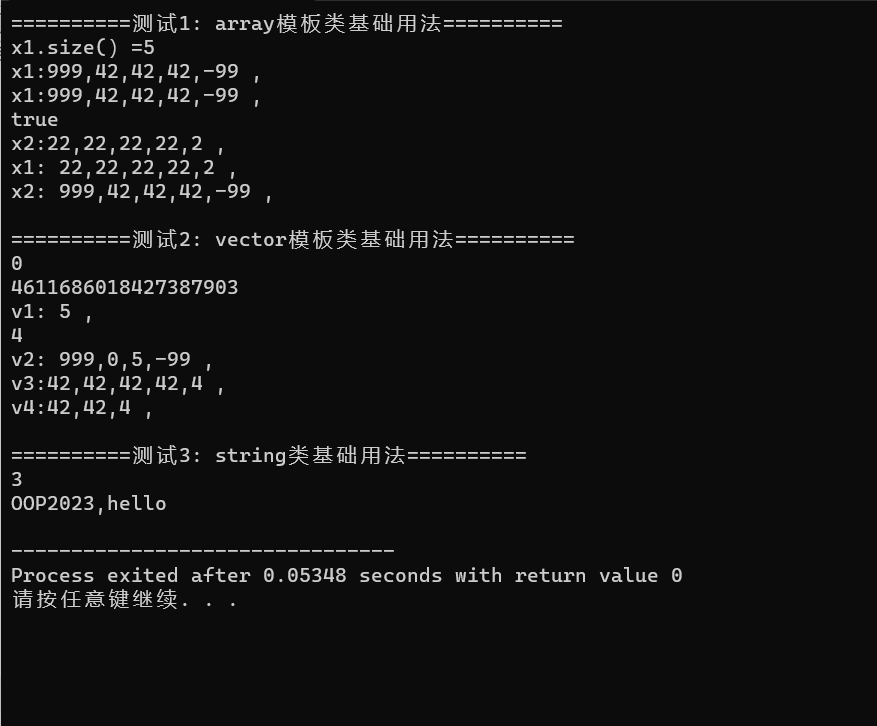
#include <iostream> #include <complex> // 测试标准库提供的复数类模板complex void test_std_complex() { using namespace std; complex<double> c1{3, 4}, c2{4.5}; const complex<double> c3{c2}; cout << "c1 = " << c1 << endl; cout << "c2 = " << c2 << endl; cout << "c3 = " << c3 << endl; cout << "c3.real = " << c3.real() << ", " << "c3.imag = " << c3.imag() << endl; cout << "c1 + c2 = " << c1 + c2 << endl; cout << "c1 - c2 = " << c1 - c2 << endl; cout << "abs(c1) = " << abs(c1) << endl; // abs()是标准库数学函数,对复数取模 cout << boolalpha; // 设置bool型值以true/false方式输出 cout << "c1 == c2: " << (c1 == c2) << endl; cout << "c3 == c2: " << (c3 == c2) << endl; complex<double> c4 = 2; cout << "c4 = " << c4 << endl; c4 += c1; cout << "c4 = " << c4 << endl; } int main() { test_std_complex(); }
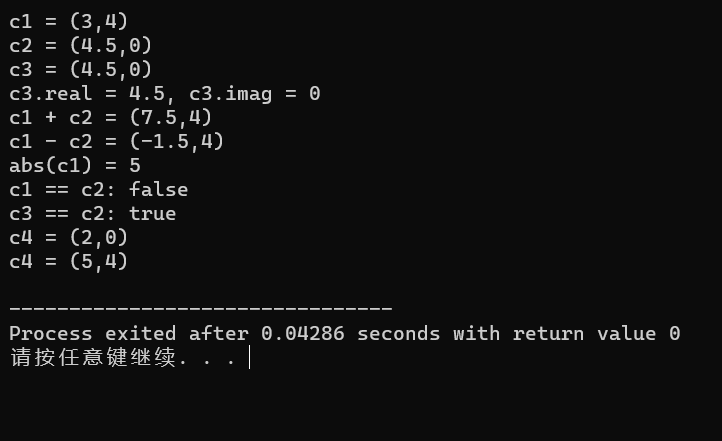
// 一个简单的类T:定义、使用 #include <iostream> #include <string> using namespace std; // 类T的声明 class T { public: T(int x = 0, int y = 0); // 带有默认形值的构造函数 T(const T &t); // 复制构造函数 T(T &&t); // 移动构造函数 ~T(); // 析构函数 void set_m1(int x); // 设置T类对象的数据成员m1 int get_m1() const; // 获取T类对象的数据成员m1 int get_m2() const; // 获取T类对象的数据成员m2 void display() const; // 显示T类对象的信息 friend void func(); // 声明func()为T类友元函数 private: int m1, m2; public: static void disply_count(); // 类方法,显示当前T类对象数目 public: static const string doc; // 类属性,用于描述T类 static const int max_count; // 类属性,用于描述T类对象的上限 private: static int count; // 类属性,用于描述当前T类对象数目 }; // 类的static数据成员:类外初始化 const string T::doc{"a simple class"}; const int T::max_count = 99; int T::count = 0; // 类T的实现 T::T(int x, int y): m1{x}, m2{y} { ++count; cout << "constructor called.\n"; } T::T(const T &t): m1{t.m1}, m2{t.m2} { ++count; cout << "copy constructor called.\n"; } T::T(T &&t): m1{t.m1}, m2{t.m2} { ++count; cout << "move constructor called.\n"; } T::~T() { --count; cout << "destructor called.\n"; } void T::set_m1(int x) { m1 = x; } int T::get_m1() const { return m1; } int T::get_m2() const { return m2; } void T::display() const { cout << m1 << ", " << m2 << endl; } // 类方法 void T::disply_count() { cout << "T objects: " << count << endl; } // 友元函数func():实现 void func() { T t1; t1.set_m1(55); t1.m2 = 77; // 虽然m2是私有成员,依然可以直接访问 t1.display(); } // 测试 void test() { cout << "T class info: " << T::doc << endl; cout << "T objects max_count: " << T::max_count << endl; T::disply_count(); T t1; t1.display(); t1.set_m1(42); T t2{t1}; t2.display(); T t3{std::move(t1)}; t3.display(); t1.display(); T::disply_count(); } // 主函数 int main() { cout << "============测试类T============" << endl; test(); cout << endl; cout << "============测试友元函数func()============" << endl; func(); }
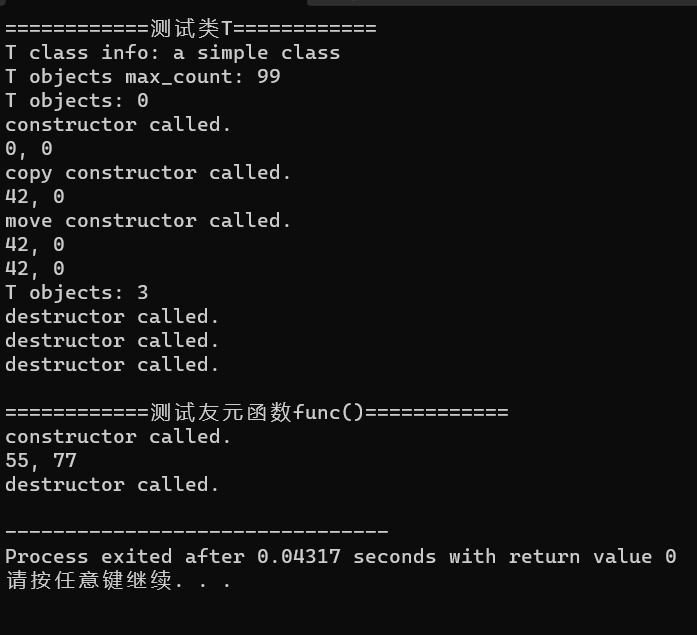
#include <iostream> #include <string> #include <iomanip> using namespace std; class Rect { public: Rect(double l=2.0, double w=1.0) { length=l; width=w; } Rect(Rect &genburten) { this->length=genburten.length; this->width=genburten.width; } double len() { return length; } double wide() { return width; } double area() { return length*width; } double circumference() { return (width+length)*2; } void resize(double times) { length=times*length; width=width*times; } void resize(double l_times, double w_times) { length=l_times*length; width=w_times*width; } int size_info() { static int i=0; i++; cout<<i<<endl; } char* doc() { return "a simpe Rect class"; } ~Rect(){}; private: double length; double width; }; // 矩形类Rect的定义 // 待补足 // ××× // 普通函数:输出矩形信息 void output(const Rect &r) { cout << "矩形信息: " << endl; cout << fixed << setprecision(2); // 控制输出格式:以浮点数形式输出,小 // 补足代码:分行输出矩形长、宽、面积、周长 // ××× cout<<"长: "<<Rect::length <<endl; cout<<"宽: "<<Rect::width <<endl; cout<<"面积: "<<r.area() <<endl; cout<<"周长: "<<r.circumference() <<endl; } // 测试代码 void test() { cout << "矩形类信息: " << Rect::doc << endl; cout << "当前矩形对象数目: " << Rect::size_info() << endl; Rect r1; output(r1); Rect r2(4, 3); output(r2); Rect r3(r2); r3.resize(2); output(r3); r3.resize(5, 2); output(r3); cout << "当前矩形对象数目: " << Rect::size_info() << endl; } // 主函数 int main() { test(); cout << "当前矩形对象数目: " << Rect::size_info() << endl; }
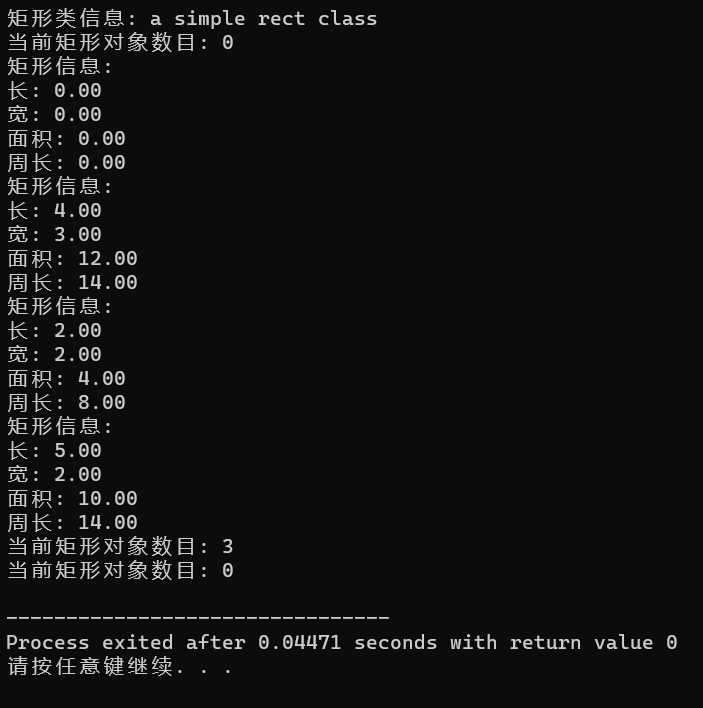
#include <iostream> #include <cmath> class Complex { private: double real; double imag; public: Complex(); Complex(double real0); Complex(double real0,double imag0); Complex(const Complex &obj); double get_real()const; double get_imag()const; void show()const; void add(const Complex &obj); friend Complex add(Complex obj1,Complex obj2); friend bool is_equal(const Complex &obj1,const Complex &obj2); friend double abs(const Complex &obj); }; Complex::Complex() { real=imag=0; } Complex::Complex(double real0) { real=real0; imag=0; } Complex::Complex(double real0,double imag0) { real=real0; imag=imag0; } Complex::Complex(const Complex &obj) { real=obj.real; imag=obj.imag; } double Complex::get_real()const { return real; } double Complex::get_imag()const { return imag; } void Complex::show()const { if(imag!=0) std::cout<<real<<imag<<"i"; else std::cout<<real; } void Complex::add(const Complex &obj) { real=real+obj.real; imag=imag+obj.imag; } Complex add(Complex obj1,Complex obj2) { obj1.real=obj1.real+obj2.real; obj1.imag=obj1.imag+obj2.imag; return obj1; } bool is_equal(const Complex &obj1,const Complex &obj2) { if(obj1.real==obj2.real&&obj1.imag==obj2.imag) return true; else return false; } double abs(const Complex &obj) { return sqrt(pow(obj.real,2)+pow(obj.imag,2)); } void test() { using namespace std; Complex c1(3, -4); const Complex c2(4.5); Complex c3(c1); cout << "c1 = "; c1.show(); cout << endl; cout << "c2 = "; c2.show(); cout << endl; cout << "c2.imag = " << c2.get_imag() << endl; cout << "c3 = "; c3.show(); cout << endl; cout << "abs(c1) = "; cout << abs(c1) << endl; cout << boolalpha; cout << "c1 == c3 : " << is_equal(c1, c3) << endl; cout << "c1 == c2 : " << is_equal(c1, c2) << endl; Complex c4; c4 = add(c1, c2); cout << "c4 = c1 + c2 = "; c4.show(); cout << endl; c1.add(c2); cout << "c1 += c2, " << "c1 = "; c1.show(); cout << endl; } int main() { test(); }
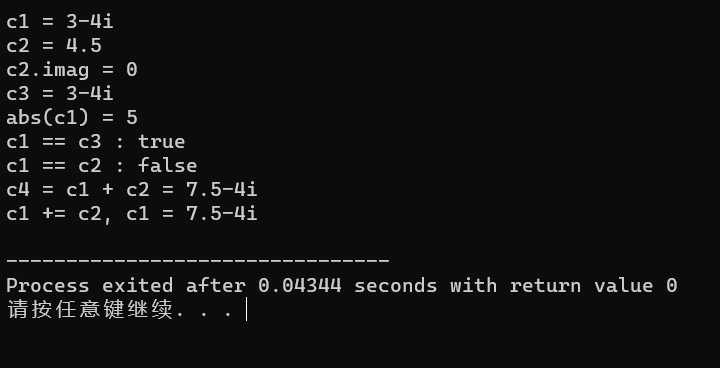



 浙公网安备 33010602011771号
浙公网安备 33010602011771号